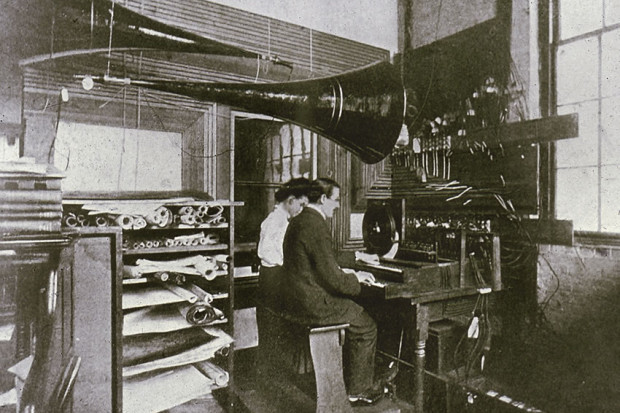Live Reviews: Ryoji Ikeda
IMMA Great Hall
5 October 2007
Ours is an information age. A tsunami of data surrounds us, overwhelms us, governs us. Ikeda takes streams from this flood and interprets them musically and visually. He is a sound engineer, crafting real time audiovisuals. A congregation, facing a large screen flanked by two towers of speakers, gathered in the IMMA’s Great Hall to witness a performance of two works by the Japanese artist Ryoji Ikeda. C4I draws on human activity, such as global economics and research mathematics, as well as the natural world; Datamatics [ver.1.0] looks outwards, towards space and abstraction.
The English physicist Paul Dirac said that ‘A great deal of my work is just playing with equations and seeing what they give.’ An equation is a statement in perfect balance. For Ikeda, equations can lead to unexpected places, from quiet beauty to overwhelming white noise. In C4I he asks ‘Shall I project the world?’ It proceeds as a display of filmed images of landscapes that are progressively rewritten as data. We fly as with Google Earth, with a soundtrack dynamically connected to the on-screen visuals. Here Ikeda sweeps cross-hairs over landscapes picking out details that form the basis of rhythm, or that allow for the development of endless repetitions of electronica.
Abruptly the continents appear, gradually overlaid with interlinking lines. Swathes of the planet remain dark, others become obscured, losing all shape. What information is being mapped? Internet traffic volume? Flight paths? The music matches it. Growing from structured and gentle to a storm. ‘All stable processes, we shall predict. All unstable processes, we shall control.’ Texts from Paul Virillo, Walter Benjamin and Alan Turing among others, comment on the artwork’s title, a military equation: Control, Command, Communicate, Computers, Intelligence. Is this an equation in balance? Koyaanisquatsi is brought to mind, the film scored by Philip Glass. But the organ and choir are replaced by the ping of sonar, the white noise of the modem.
Datamatics is visually more austere: black and white with accent points in red. Ikeda strives to make the invisible visible, beginning two-dimensionally using pure data derived from hard drive errors and software code. So much of us is translated into numbers dynamically and invisibly. Our hard drives are hardly stuffed with photographs and letters. Morse code was more truthful than a graphical user interface. The first half of Datamatics streams with numbers and lines, dots and dashes.
Suddenly we are shown a three-dimensional representation of the stars in our night sky. This is rotated systematically, providing rhythm, and swept by cross-hairs, metronomic as a pulsar. SETI, the search for extra-terrestial intelligence, scans the heavens for the faintest traces of signal in noise.
Ryoji Ikeda is an architect of information, creating structures of beauty and complexity. ‘What is mind? Never matter. What is matter? Never mind.’ Ikeda moves us to the sublime through overwhelmed senses. Afterwards, there still was an echo in the ear, a faint image on the retina, a subtle rewiring of the matter of the mind.
Published on 1 November 2007
Seán Ó Máille is a freelance critic, photographer and full-time secondary teacher in Dublin.














